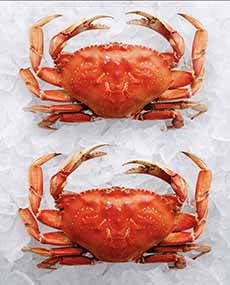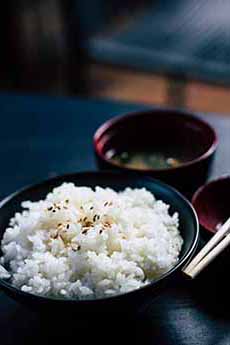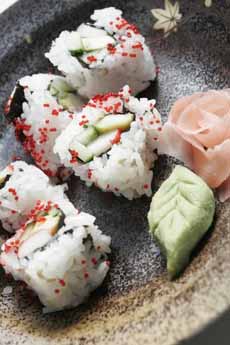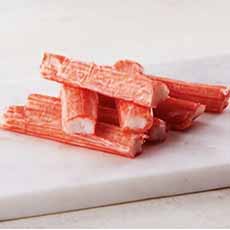Scattered California Roll, California Roll Chirashi Sushi
|
This Scattered California Roll comes under the category of “Why didn’t we think of this?” But we’re thankful that Grace Parisi came up with the idea (there’s more about Grace below). This recipe is in the chirashi sushi category. The name means “scattered sushi” in Japanese, and it’s the easiest sushi to make because, rather than rolling everything nice and tidy in a sheet of seaweed (it takes both practice and seaweed), the ingredients are scattered atop a bowl of rice. Grace combined the idea with grain bowls, and you can substitute your grain of choice for the rice. Wine pairing: The flavors of toasted sesame seeds, seasoned sushi rice, and sweet crab pair well with a crisp, aromatic Austrian Riesling. > Check out the different types of sushi and sashimi in our Sushi Glossary. > The history of the California Roll is below. > The original California Roll history. This recipe is made with fresh Dungeness crab meat, but if you can’t get it, substitute one whole bairdi crab cluster (1 body, 4 legs, 1 claw), a type of snow crab. Other options: canned lump crab meat or crab stick (the different types of crab meat). Prep time is 30 minutes. 1. MAKE the rice. In a small bowl, combine 2 tablespoons of the rice vinegar with the sugar and ½ teaspoon salt, stirring until dissolved. Set aside. 2. COMBINE the rice with 2 cups of water in a medium saucepan, and bring to a boil over high heat, Reduce the heat to low, cover, and cook until the liquid is absorbed, about 15 minutes. Let the pot sit off the heat, covered, for 10 minutes. 3. SPREAD the rice in a large shallow bowl or on a baking sheet and toss with the reserved sweetened vinegar. Refrigerate briefly until cool. Meanwhile… 4. STEAM the crab. Fill a large skillet with 1 inch of water and bring to a boil over high heat. Add the crab, cover, and steam for 2 to 3 minutes, until just heated through. Remove the meat and break it into 1-inch pieces. You can save shells for stock (stick them in the freezer for future use). 5. PREPARE the dressing. In a small bowl, combine 2 tablespoons of rice vinegar with the soy sauce, oil, ginger, and wasabi paste. Season with salt. 6. ASSEMBLE AND SERVE. Add the radishes, scallions, and cucumbers to the rice, pour the dressing over them, and toss gently to combine. Fold in the crab and spoon the mixture into bowls. Garnish with the avocado, sesame seeds, and shredded nori just before serving. You can wrap any leftover crab, rice, and avocado in green leaf or butter lettuce leaves for a light lunch or snack. The history of the California roll is recent, brief, and contested. A North American invention, there are two different sources for the original California roll. One says that it was first made in the 1960s by Ichiro Mashita, a sushi chef who worked at Tokyo Kaikan in Los Angeles’ Little Tokyo. He started to use creamy avocado as a replacement for toro, the creamiest cut of tuna, which wasn’t always available. He combined it in a roll with cucumber and fish cake (the latter two traditional sushi bar ingredients) into a maki (roll) sushi. He subsequently substituted real crab for the fish cake, and did something about the fact that some of his American customers were still picking off the unfamiliar nori from the outside of his maki sushi. He decided to make the roll with the rice on the outside to hide the seaweed. He is thus credited with inventing the uramaki, a.k.a. reverse roll or inside-out roll. The technique also created a fatter roll (“more for the money?”) [source]. Also in Los Angeles, Ken Seusa of Kin Jo restaurant on La Cienega Boulevard was experimenting with Western ingredients. And he also began making uramaki with avocado, cucumber and crab. He was given the credit for its invention by Gourmet magazine in 1980, but Mashita-san became viewed as the creation of the precursor. We don’t know who made the cost-saving substitution of crab stick/imitation crab/sea leg/surimi‡ (photo #8) for real crab leg. And now, the name California roll. Hidekazu Tojo, a chef and sushi chef from Osaka, Japan, moved to Vancouver, British Columbia, in 1971. Japanese food had not yet taken off; the city had just four Japanese restaurants at the time. Since Canadians (as well as Americans) were not used to consuming raw fish, he tweaked a roll that could be enjoyed by anyone. This included cooked crab (now often substituted by the more affordable crab stick) instead of raw fish. The name “California” was bestowed by visitors from Los Angeles, to honor their home state, the continent’s avocado capital. Some sources state that Tojo named it in their honor. Both the California roll and the California roll temaki (hand roll), where the ingredients are wrapped in a cone of nori (dried seaweed), became popular among both fans and non-consumers of raw fish. The wildly-popular roll continues to evolve. Variations include spicy California roll, mango California roll, and a garnish of sesame and/or roe on the outside (photos #6 and #7). Not to mention crunchy California roll, deep fried with eel sauce, and crispy California roll that contains fried tempura flakes. It is also made with crab salad (authentic or imitation). Tojo is also credited with the invention of the B.C. (for British Columbia) roll, an uramaki of cooked salmon in a sweetened barbecue sauce, and cucumber. There are variations of this roll that include barbecued salmon skin with mayonnaise [source]. |
|
|
|
WHAT IS JAPANESE RICE? WHAT IS SUSHI RICE? Japanese rice, the rice served at every Japanese meal, is a cultivar of Japonica (a.k.a. sinica) rice. It is one of the two major domestic types of Asian rice varieties*. The plump, short grains have a characteristic sticky, firm texture and are slightly sweet. When cooked, they are sticky enough to easily be picked up with chopsticks. (Here’s more about Japanese rice.) Sushi rice is made by seasoning this Japanese short-grain rice with a mixture of rice vinegar (a mild form of vinegar), sugar, salt, and often kombu (kelp). These seasonings impart a balance of sweet, salty, and sour taste flavors that pair so well with the raw fish. The term sushi means vinegared rice: su = vinegar, shi = rice. Sitka Salmon Shares’ Culinary Director Grace Parisi is a cook, writer and cookbook author. Formerly the Senior Test Kitchen Editor at Food & Wine Magazine and Executive Food Director at TimeInc Books, her work has appeared in Cooking Light, Health, O Magazine, Epicurious, Fitness, Today, Serious Eats, Martha Stewart, and many more. She’s the author of more than 6 books, among them The Portlandia Cookbook and Get Saucy, which was nominated for a James Beard award for Best Single Subject Cookbook. *Japonica rice is extensively cultivated and consumed in East Asia, whereas in most other regions of Asia, indica rice is the dominant type of rice. Here’s the difference between the two. In California, rice production is dominated by short and medium-grain japonica varieties, including cultivars developed for the local climate, such as Calrose. A cultivar is a type of plant that people have bred for desired traits (selective breeding). Many cultivars of rice are grown worldwide. The two major subspecies (indica and japonica) have more than 40,000 varieties. Here’s a small list of them. †Pickled ginger recipe: If you can’t find pickled ginger in the Asian products aisle of your supermarket or a local Asian grocer, make your own. Use 1 teaspoon each grated fresh ginger, rice vinegar, and sugar. Allow the flavors to meld for an hour or more. ‡Surimi was created in Japan in the 12th century. Chefs would grind and salt leftover fish as a means of preserving their extra catch. In the 1960s, a Japanese chemist discovered that by adding sugar to the traditional surimi-making process, he could stabilize the product, freeze it, and preserve its shelf life. Here’s more about surimi. CHECK OUT WHAT’S HAPPENING ON OUR HOME PAGE, THENIBBLE.COM.
|
||









